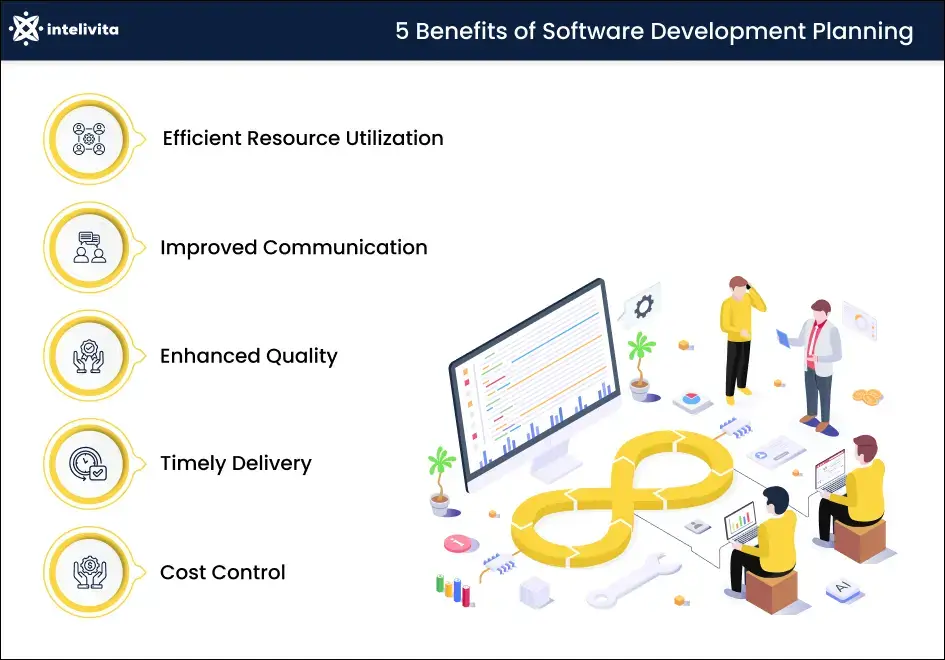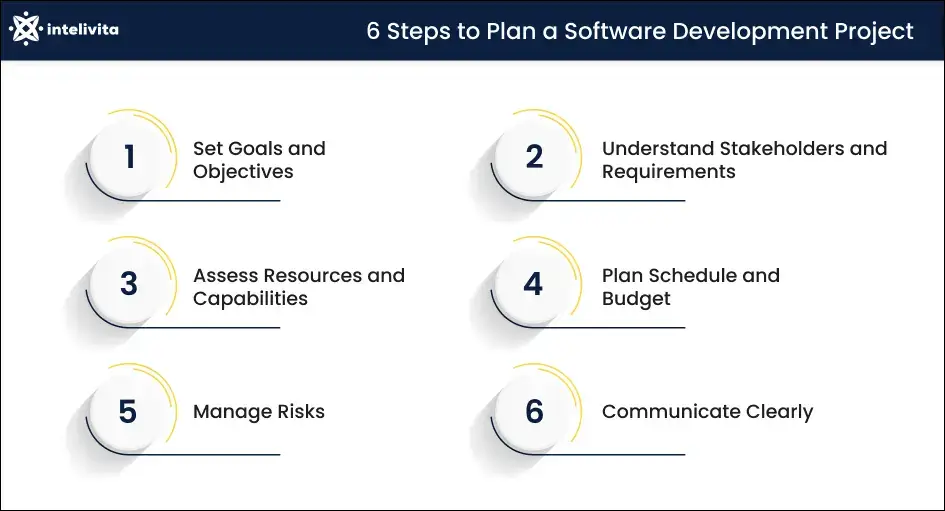Research stated that only around 30% of software projects are successful. One of the main reasons is the lack of thorough software project plan.
Software development planning is the foundation of successful software projects.
It’s all about setting clear goals, understanding what you need, managing resources, sticking to a schedule, and handling potential risks.
When you invest time in planning, your project’s success rate goes up, and you can provide users with top-quality software.
In this article, we’ll explain the importance, benefits, steps, and additional tips for planning a software development project.
Therefore, you can help guarantee the success of your software project.
Why is Software Development Planning Important?
Software development project planning is vital for several reasons:
Alignment with Goals
It plays a significant role in aligning the project with the overarching goals and objectives of the organization.
This ensures that your software project is not a standalone effort but a piece of the larger puzzle, contributing to the strategic vision.
Resource Optimization
Effective planning leads to the efficient allocation of resources.
This means that you don’t waste valuable time, money, and manpower on unnecessary or unproductive activities, thus cutting cost overruns.
Risk Mitigation
Through careful planning, you can identify and address potential risks.
These could be technical challenges, unexpected delays, or other obstacles. Addressing them early helps minimize their impact on the project.
Stakeholder Engagement
Involving stakeholders in the planning process fosters collaboration and ensures that everyone is on the same page.
When stakeholders understand and endorse the plan, it’s more likely to succeed.
Project Control
Planning software project provides a structured framework for monitoring and controlling the project’s progress. It’s like having a map to track your journey.
This control is essential to ensure the project stays on course and any deviations are addressed promptly.
Benefits of Software Development Planning
Effective software development planning offers numerous advantages, including:
Efficient Resource Utilization
Planning ensures that resources — be it time, money, or manpower — are used optimally.
This means reducing waste and ensuring that each resource is employed to its maximum potential.
Improved Communication
When a plan is in place, communication becomes clearer and more effective.
Team members and stakeholders understand their roles and the project’s progression, reducing misunderstandings and conflicts.
Enhanced Quality
Planning allows for thorough testing and quality assurance. This ensures that the end product meets the expected standards of quality.
Timely Delivery
Setting realistic schedules and milestones is a critical aspect of planning. With a well-structured plan, projects are more likely to be completed on time.
Cost Control
Budget management and cost control are inherently tied to the planning process.
A well-structured plan enables the tracking of expenditures and ensures that costs do not spiral out of control.
6 Steps to Plan a Software Development Project
Below are the steps you can follow to plan your software development project.
We’ll also go through practical examples for each step, so you’ll understand clearly.
#1. Setting Clear Goals and Objectives
The first step in planning a software development project is to set clear and achievable goals and objectives.
You need to answer the fundamental question: What do you aim to achieve?
Whether it’s enhancing user experience, boosting sales, or optimizing a business process, well-defined objectives form the foundation of your project.
Write down your goals and objectives in a clear and concise manner, ensuring they are communicable to your team and stakeholders.
For instance, let’s say you’re building an online store application project.
The goal is to increase the company’s sales by 20%. Key features and functionality may include product search, product reviews, and a secure checkout process.
#2. Understanding Stakeholders and Requirements
Identifying your project’s stakeholders and understanding their requirements is pivotal.
Stakeholders include anyone affected by or involved in your project, both internally, like team members, and externally, like customers or partners.
Understanding their needs and expectations from the outset fosters collaboration and a shared project vision.
Following the example above, stakeholders and requirements for the online store application may include:
- Customers, who require easy shopping and secure checkout.
- Merchants, who require product listing and sales tracking.
- Development team, who require project building and issue management.
#3. Resource Assessment and Capability Check
Early in the planning process, assess your available resources and capabilities.
This involves evaluating your team’s skills, the tools at your disposal, and the necessary infrastructure.
This assessment helps pinpoint potential resource gaps and paves the way for effective planning.
For instance, the online store platform development team has experience in web applications. The team has access to essential tools and infrastructure, such as development servers and databases.
#4. Creating a Realistic Schedule and Budget
Establishing a realistic project schedule and budget is paramount for effective project management.
This involves breaking down the project into smaller, manageable tasks and estimating their duration and costs.
A detailed schedule and budget act as a roadmap for your project, enabling you to monitor progress and stay on course.
In the case of the online store software, the project schedule outlines key milestones, such as the development of product search, product reviews, and the checkout process.
Additionally, the budget should encompass the costs related to development, hosting, and marketing.
To help manage your software development timeline, pick a project management style that fits your team. Below are some popular styles to try:
Kanban: Kanban is a visual task management system designed to help teams visualize their work, identify bottlenecks, and optimize workflow.
Gantt Charts: Gantt charts are bar charts that display task start and end dates along with their dependencies, providing a clear visual representation of the project’s timeline.
#5. Effective Risk Management
The next step involves identifying potential risks and developing strategies to address them.
Risks can be anything that might negatively impact your project, from technical challenges to resource constraints.
Thus, developing a risk management plan is crucial to minimize disruptions.
See the example below for the online store software’s risk management plan.
| Risk | Management Strategy |
| Technical Issues |
|
| Development Delays |
|
| Changing Customer Requirements |
|
| Resource Constraints |
|
| Scope Creep |
|
#6. Establishing a Clear Communication Plan
Effective communication is essential throughout your software development project.
By creating a well-defined communication plan, you outline how you will communicate with stakeholders.
This includes specifying the frequency of communication, the channels of communication, and key stakeholders for updates.
In the online store platform’s case, the communication plan may include:
- Weekly updates for the project manager through messaging applications.
- Biweekly meetings with the customer team through video conference calls.
- Monthly newsletter for merchants through emails.
How to Plan a Software Development Project?
In addition to the guide, we’ll also explore some handy tips to improve your software development project plan’s efficiency.
- Set Realistic Deadlines — Avoid rushing. Set practical deadlines, including some buffer time for unexpected delays.
- Divide and Prioritize Tasks — Break down the project into smaller, more manageable tasks.
It eases tracking progress and prevents feeling overwhelmed. Then, focus on the most critical ones first. - Be Transparent — Honesty about the project’s status, even when facing challenges, builds trust and confidence.
- Celebrate Achievements — Recognize and reward your team’s hard work along the way to keep motivation high.
Takeaways
In this article, we’ve learned that software development planning is a crucial process that lays the foundation for successful software projects.
Effective planning leads to efficient resource utilization, improved communication, enhanced quality, timely delivery, and cost control.
The key steps in planning a software development project include:
- Setting clear goals and objectives
- Understanding stakeholders and requirements
- Assessing resources and capabilities
- Creating a realistic schedule and budget
- Developing a risk management plan
- Establishing a clear communication plan
By following these steps and best practices, you can increase your chances of success and deliver a high-quality product to your users.
For high-quality and well-planned software, consider Intelivita.
Our software development services have more than a decade of experience and over 600 success stories.







